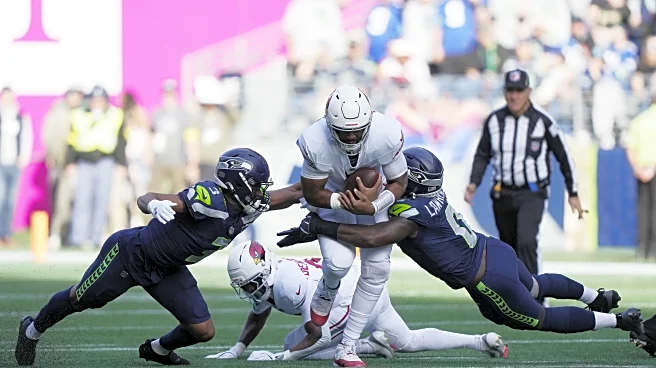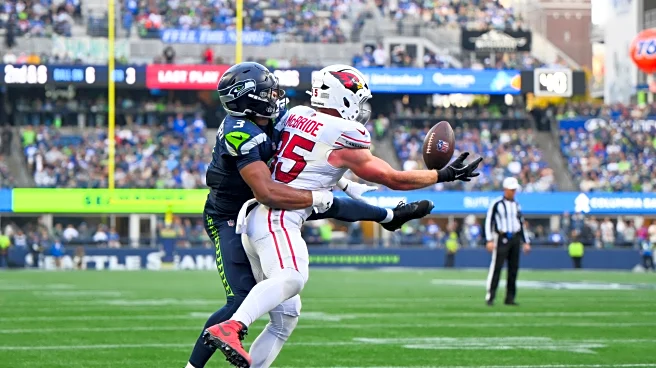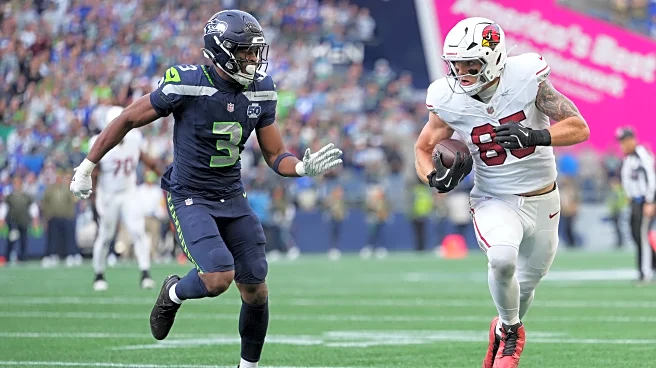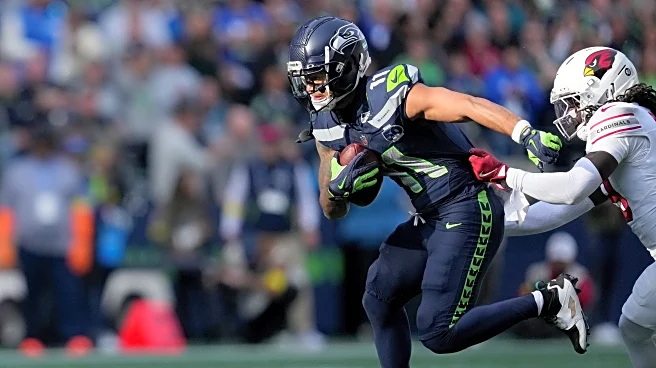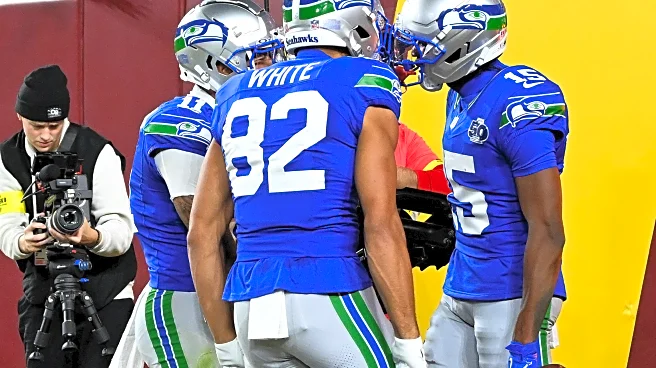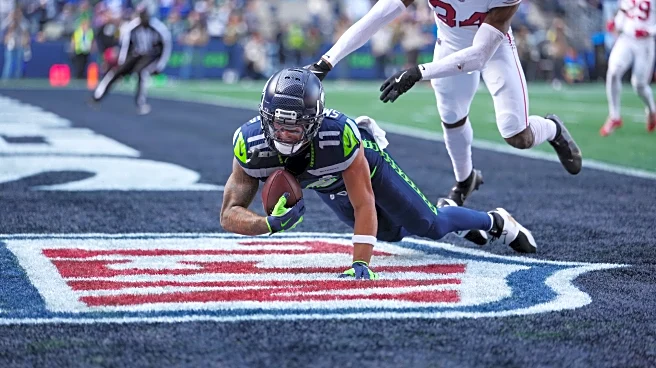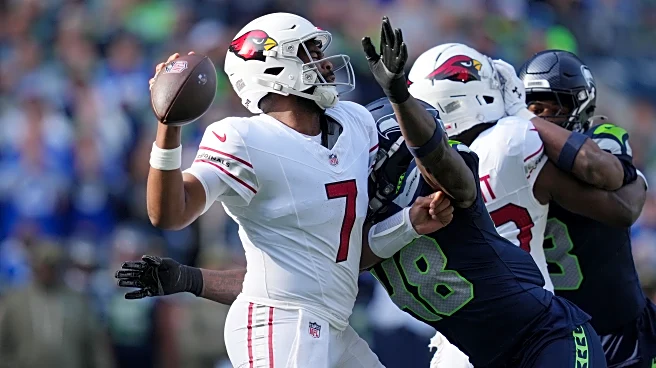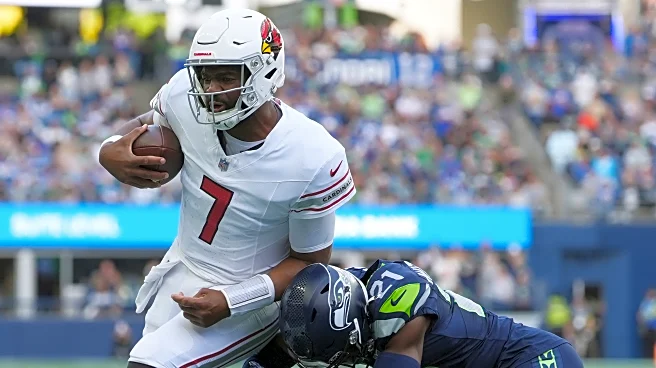Another game where the Seahawks practically decided the match in the first half. The starters could have rested longer if it weren’t for the series of turnovers. The victory kept the Seattle Seahawks in the lead
of the NFC West before the important game against the Los Angeles Rams.
All data used in this All-22 film breakdown article was taken from PFF.
The Bad
Misuse of the cap space
In June 2025, Michael Dickson signed a four-year, $16.2 million contract extension, which includes $7.5 million guaranteed and makes him the highest-paid punter in the NFL.
The Seahawks spent all that money, and in the last game, Dickson didn’t even punt.
Absurd!
Of course, this is just a joke.
This happened because all of the Seahawks’ drives ended in either scoring or turnover (excluding kneeling). Since being drafted in 2018, this is the third time this has happened.
The other times were:
– Loss against Dallas, in 2023
– Win against the Lions, in 2022
Turnovers, Turnovers and Turnovers
Despite the Seahawks’ offense performing very well and attracting the attention of the NFL, the team has suffered from turnovers. Only against the Jaguars did the team not commit turnovers (in the first game against the Cardinals, the offense did not commit turnovers, but Coby Bryant fumbled after the interception). The turnover differential is at -4, the defense managed two fumbles against the Cards, but the offense still managed to overcome it with 3 turnovers.
If you make these mistakes against the Commanders, Saints, Cardinals, it is possible to recover. Making these mistakes against teams of the Rams’ caliber, the price to pay can be very high. Of the three turnovers committed, two resulted in TDs for the Cardinals. These two TD drives totaled only 22 yards. Even with the defense playing at a dominant level, the unit is placed in an unfavorable situation.
The first turnover occurred due to a snap problem with Olu Oluwatimi, the backup center, handing the ball over inside the red zone to the Cardinals.
The second is Sam Darnold’s interception. In this one, I basically completely absolve Darnold of blame. The call wasn’t the best, putting pressure on the ball inside the end zone calling a pass (remember that against the Texans there was a forced fumble returned for a TD). Furthermore, AJ Barner is easily moved and deflects Darnold’s pass, which ends up in the CB’s hands.
The third was the only one that didn’t end in a TD for the Cardinals. Abe Lucas is moved by Josh Sweat’s bull rush, but manages to recover. The EDGE deserves a lot of credit for stretching his arm at the right moment to force the fumble. Darnold kept an eye on JSN’s route and may have gotten stuck on that read before progressing to the second read, Elijah Arroyo.
Offensive Line is not a finished product
The offensive line’s numbers against the Cardinals were: 200 rushing yards (excluding kneeling) and only one sack allowed. These seem like dominant numbers, but watching the tape, it’s easy to find highs (very high) and lows (very low).
There are many execution errors and many moments where a mistake by one of the five offensive linemen ends up resulting in the failure of the play. In the play above, Abe Lucas arrives late to block the relentless Calais Campbell, and this error in the pull causes Ken Walker to be tackled behind the line.
The offensive line can’t create space, and with Grey Zabel and AJ Barner being beaten on the blocks, they leave the running back with no options.
The double-team of Zabel and Oluwatimi isn’t well synchronized and allows the defensive lineman to penetrate, along with Bradford being dominated by Walter Nolen, forcing Walker into a cutback, but rookie Nick Kallerup commits a hold.
In this play, only Abe Lucas succeeds. Jalen Sundell and Zabel’s blocks are not synchronized, as is Charles Cross and Barner’s. Again, the RB has no way out.
Here we have a mistake that results in a TD. The left side of the Cards’ DL is slanting inside. This causes Bradford to block the wind and end up on the ground. Lucas also loses it initially, but recovers by sealing the edge and allowing George Holani to cut. It is worth noting the good blocking by rookie Elijah Arroyo.
The Good
Klint Kubiak making his case for a Head Coach position
Kubiak has been improving his game and is on an upward trajectory with good calls exploiting opposing defenses. This has led to his name being considered for the next Head Coach cycle.
Let’s start by highlighting the play-action, which is fundamental to the success of the offense. In addition to manipulating the LBs, he uses the TEs a lot to reinforce pass protection. In this play, Kallerup simulates a split zone, but, since it’s a pass, it only allows for different protection in an attempt to disrupt the DL. The rookie TE blocks the EDGE and allows the LT to block the innermost gap.
Play-action deep shot here. See Kallerup again coming to block on the opposite side, creating a pocket with him, Barner, and Walker in protection. JSN keeps the CB hesitant, and he ends up free for a deep touchdown. Notice the impact of Rashid Shaheed. His route forces Budda Baker into the over route, leaving the CB 1v1 against JSN.
In this play, he calls a concept that’s trending in the NFL, the Insert Flash (one of the routes happens in the C gap, in this case is Cooper Kupp’s route, like Insert concept for run). If you think you recognize the play, it’s similar to JSN’s TD against the Saints. Going back to the concept, we have a play-action with a threat from a midzone or wide zone to one side, in order to move the LBs in one direction, while the routes attack the other side. The idea is to have three routes at different levels. The TE’s route, which stays in the block before running the flat (flash) route, a deeper route, and an intermediate route. Usually, the target ends up being the short route, like a checkdown, or the intermediate route, since the defense is stressed vertically with the short route and the other deep route, as was the case in this play.
Kubiak opened the playbook here. Two players in the backfield, one of them TE Elijah Arroyo. The Seahawks simulate a counter with the LG and TE going to block on the opposite side (note the #89 running over Budda Baker). This moves the entire defense in one direction, but it’s a fake, and the ball is delivered into an end round, with the tight end who was in the backfield serving as a lead block. Creativity and misdirections, something the Seahawks’ offense has lacked in recent seasons.
The magic of Mike Macdonald’s pressures
The defense played poorly in the loss against the Bucs. Since then, Macdonald has been playing defensively one game after another.
One of the concepts that was used extensively in both games against the Cardinals was to force and try to box in Trey McBride’s routes. This worked most of the time, especially in the first game with Julian Love almost getting an interception and Devon Witherspoon making a beautiful pass deflection.
Here, although it resulted in a reception, it was a good process for the defense. Boye Mafe’s alignment forces the route to come inside him, then Drake Thomas’s positioning narrows the options for McBride. The idea is to limit McBride’s action and give Ty Okada less space to cover. The safety ends up being a little late and the reception happens, but covering McBride is a complicated task.
I really liked the design of this simulated pressure. In addition to the 4 DLs, the team has threats from the two ILBs (#42 and #48), the safety (#39), and Nick Emmanwori (#3). Notice that there are 3 blitzers on the right side of the OL and only one on the left side (#3). This forces the OL to slide to the right. But, the ILBs, safety, and EDGE drop into coverage, and the blitz comes from the other side. At one point, there are 4 OLs blocking Mike Morris. The center still manages to adjust and block Emmanwori, but Derick Hall has a clear path to the QB, who escapes the sack at the last second.
Jacoby Brissett had Trey McBride open, but his hesitation is the time needed for the blitz to reach him. The Cardinals have an additional OL, but it had been a trend in the Arizona offense that when this sixth OL was one yard behind the OL, he was sent in motion to the opposite side. The Seahawks threaten with the blitz of Coby Bryant and Emmanwori. The offensive line prepares for this and has the guard and tackle, plus the running back blocking the edge rusher Demarcus Lawrence and the two blitzers. Macdonald adds Tyrice Knight in a cross blitz with Lawrence. Notice how #0 aggressively attacks the inside gap. The idea is to create space for the linebacker, and that happens. The fumble is forced and results in a touchdown.
Again, a defensive touchdown for the Seahawks on a fumble forced by Knight and recovered by Lawrence. The pass coverage gave the quarterback no options, who held the ball long enough for the sack to happen again. The Seahawks execute a pick stunt, something that was a trademark of the Ravens’ defense with Macdonald and very well executed by Patrick Queen. Knight attacks the A gap vertically, and when the running back positions himself to block, he changes his trajectory to attack the guard and create space for Lawrence. The play was designed for Lawrence to get to the QB, but Knight managed to do more than expected, getting a sack and forcing a fumble that was subsequently returned for a touchdown.
Final Thoughts
As mentioned in one of the topics, the sentiment may seem contradictory, with a dominance of 35 points in the first half, but three turnovers, two of which ended in TDs. On the defensive side, it was suffocating and gave the Cardinals no chance. The only TD conceded that didn’t come from a turnover happened at the end of the game.
There’s a lot of positive stuff to lean on, but it’s necessary to pay attention to these mistakes, thinking about the future and, if all goes well, the postseason.
